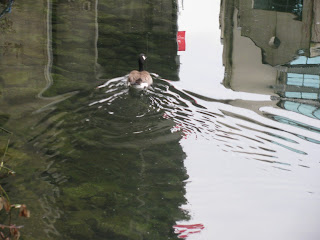Once upon a time, somewhere between the water and the sky, there was an enchanted island that was not quite an island. To this magic land, in the dark of autumn and winter, our intrepid grey-haired adventuress was drawn in pursuit of her mythic late-life quest.
Laden with a knapsack of special wands and sustained by a custom-brewed elixir...
she explored the Not Quite Island, discovering many things there that were Not Quite what they seemed to be. She found a mermaid, locked in wood but still smiling:
and a school of silver fishes, flashing through the air.
She learned that seagulls could overpower humans....
...but that Genial Giants ruling the island's cement plant spread a benevolent influence over all.
She found treasure troves of colour and shape displayed in the open...
and came at last to the site where treasures were hidden and yet to be revealed:-- a creaking old building destined to vanish in the summer of 2017.
Here, she met with an unexpectedly congenial troop of comrades (most of them half her age), each of whom was pursuing her/his own quest. But under the guidance of a Wise Woman delegated to instruct them, they all learned together the Four Magic Questions that they could expect to be asked, again and again, as they continued their journeys:
- Are the negative spaces interesting?
- Is there an overall balance?
- Are the elements varied?
- And most mysterious of all: WHAT IF (this element were changed,
etc)..........?
Already, our heroine had proven herself through the many trials that had been set for her. (see here and here and here). Now, in these final days in the vanishing building, the Wise Woman assigned three more challenges. The first was to create a sampler of different textures.
The second was to add the element of texture to the shape of her elixir cup, the same design that had been used in a previous exercise.
This time, the emphasis was not on tone or shade but on how a pronounced texture will draw the eye.
The third and final task required careful preparation. Guided by the Wise Woman, the troop of seekers discussed, first, the symbolism of different colours, recognizing that these can vary across cultures, and second, the possible symbolism of various geometric shapes.
Then, their assignment was to recall a fairy tale, select a specific scene in it, and recreate that scene symbolically, using only two colours and black and white. This was not to be an illustration, but a symbolic representation in a composition that satisfied the Four Magic Questions.
In the spirit of the Not Quite Island, our heroine chose the story of Dvořák's opera, "Rusalka," based on a Slavic fairy tale akin to the "The Little Mermaid." The chosen scene was the unforgettable "Song to the Moon," when the Rusalka, the water nymph, sings to the moon of her love and longing for the seemingly unattainable prince. You can listen to this astonishingly beautiful song sung by the Russian soprano Anna Netrebko and be thrilled to the core. (And you can view more delights from the Not Quite Island here).
In this final stage of her quest, our elderly heroine created this symbolic representation:
Now, with her trials for this stage completed, has our Canadian Goose turned into a swan?
Not Quite, but working on it.


























